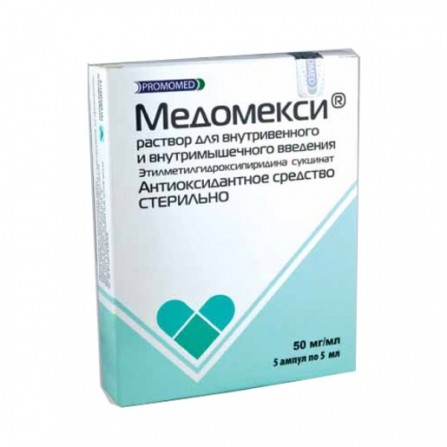Medomeksi solution for intravenous and intramuscular administration of an ampoule 5 ml 5 pcs
Condition: New product
999 Items
Rating:
Be the first to write a review!

More info
Description
Solution for intramuscular and intravenous administration Medomeksi - antioxidant drug. Improves the metabolism of brain tissue and their blood supply, improves microcirculation and rheological properties of blood, reduces platelet aggregation. Stabilizes the membrane structure of erythrocytes and platelets. It has a hypolipidemic effect, reduces the content of total cholesterol and low density lipoproteins.
Active ingredients
Ethyl methyl hydroxypyridine succinate
Composition
Ethyl methyl hydroxypyridine succinate, water for injection
Pharmacological effect
The mechanism of action is due to its antioxidant and membrane-protective action. The drug inhibits lipid peroxidation, increases the activity of the enzyme superoxide dismutase, increases the ratio of lipid to protein in the cell membrane, stabilizes the membranes of blood cells, reduces blood viscosity, increases its fluidity. Modulates the activity of membrane enzymes (calcium-independent phosphodiesterase, adenylate cyclase, acetylcholinesterase) receptor complexes (benzodiazepine, of GABA, acetylcholine) that enhances their ability to bind to ligands, promotes preservation of structural and functional organization of biological membranes, transport of neurotransmitters and improve synaptic transmission. Increases the content in the brain dopamine. It causes an increase in compensatory activation of aerobic glycolysis and a decrease in the degree of inhibition of oxidative processes in the Krebs cycle under hypoxic conditions with an increase in ATP and creatine phosphate, activation of energy-synthesizing functions of mitochondria, and stabilization of cell membranes.
Pharmacokinetics
The time to reach the maximum concentration in the blood plasma with a / m injection - 0.3-0.58 h. Cmax with a / m dose at a dose of 400-500 mg - 2.5-4 μg / ml. It is rapidly distributed in organs and tissues. Metabolized in the liver by glucuronidation. 5 metabolites have been identified: 3-hydroxypyridine phosphate is formed in the liver and, with the participation of alkaline phosphatase, decomposes into phosphoric acid and 3-hydroxypyridine, the 2nd metabolite is pharmacologically active, is formed in large quantities and is detected in the urine 1-2 days after administration, 3rd - is excreted in large quantities with urine, 4th and 5th - glucurono-conjugates.T1 / 2 and the average retention time of the drug in the body with a / m injection - 0.7-1.3 h. The drug is excreted in the urine mainly as metabolites (50% for 12 hours) and in small quantities - unchanged (0.3% for 12 h) Most intensively displayed during the first 4 hours after drug administration. Indicators of urine excretion of unchanged drug and metabolites have significant individual variability.
Indications
Anxiety disorders in neurotic and neurosis states, vascular dystonia, encephalopathy, mild cognitive disorders atherosclerotic, acute cerebrovascular accidents (in combination therapy), withdrawal syndrome in alcoholism with predominance neurosis and vegetative-vascular disorders in the complex therapy acute intoxication with antipsychotic drugs.
Contraindications
Hypersensitivity to the drug, acute liver failure, acute renal failure, lactose intolerance, lactase deficiency and glucose-galactose malabsorption syndrome, childhood.
Use during pregnancy and lactation
Contraindicated
Dosage and administration
Assign intramuscularly or intravenously (jet or drip). Doses are selected individually. The jet is slowly injected over a period of 5-7 minutes, drip at a rate of 40-60 drops / min. When the infusion method of administration of the drug should be diluted in a 0.9% solution of sodium chloride. Begin treatment with the appointment of the drug in a dose of 50-100 mg 1-3 times / day, gradually increasing it to obtain a therapeutic effect. The maximum daily dose should not exceed 800 mg. For acute disorders of cerebral circulation, they are used in complex therapy for the first 2-4 days intravenously in a dose of 200-300 mg 1 time / day, then intramuscularly in 100 mg 3 times / day. The duration of treatment is 10-14 days. When dyscirculatory encephalopathy in the phase of decompensation, the drug should be administered intravenously in a stream or drip at a dose of 100 mg 2-3 times / day for 14 days. Then the drug is administered intramuscularly 100 mg 2-3 times / day for the next 2 weeks. For course prophylaxis of dyscirculatory encephalopathy, the drug is administered intramuscularly at a dose of 100 mg 2 times / day for 10-14 days.For mild cognitive impairment, age-related cognitive decline and for anxiety disorders, the drug is used intramuscularly in a daily dose of 100-300 mg for 14-30 days. In vegetative-vascular dystonia, asthenic conditions, neurotic and neurosis-like conditions - intramuscularly at 50-400 mg / day for 14 days. In case of withdrawal syndrome, the drug is administered in a dose of 100-200 mg intramuscularly 2-3 times / day or intravenously 1-2 times / day for 5-7 days. In acute intoxication with antipsychotics, the drug is administered intravenously at a dose of 50-300 mg / day for 7-14 days.
Side effects
On the part of the digestive system: nausea, dry oral mucosa, diarrhea. Other: allergic reactions, drowsiness.
Overdose
Symptoms: possible sleep disorders (insomnia, in some cases - drowsiness). Treatment: as a rule, it is not required - the symptoms disappear on their own within 24 hours. In severe cases of insomnia, nitrazepam 10 mg, oxazepam 10 mg or diazepam 5 mg. With an excessive increase in blood pressure - antihypertensive drugs under the control of blood pressure.
Interaction with other drugs
When combined, Medomeksi enhances the action of benzodiazepine anxiolytics, antiepileptic (carbamazepine). antiparkinsonian (levodopa) drugs, nitrates. Medomeksi reduces the toxic effect of ethanol.
special instructions
Use in pediatrics: Medomeksi not prescribed to children due to insufficient knowledge of the drug.


